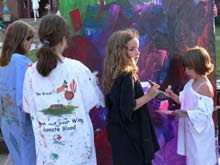 Paducah Kentucky is a small town (pop. 27,000) halfway between St. Louis and Nashville. Like many small historic downtowns, it suffered when shopping malls gained popularity in the 1960s, and up until the 1990s had yet to rebound.
Paducah Kentucky is a small town (pop. 27,000) halfway between St. Louis and Nashville. Like many small historic downtowns, it suffered when shopping malls gained popularity in the 1960s, and up until the 1990s had yet to rebound.In 2000, the City--together with Paducah Bank--embarked on an innovative program that over the next ten years would infuse its struggling Lowertown neighborhood with almost seventy artists. The project was seen as high risk at the time. The City advertised nationally for artists to relocate to Paducah and purchase and renovate historic structures with favorable financing and incentives--for example, loans have been proved at up to 300% of the appraised property value to help fund renovations. In return, artists would have to follow the City's historic preservation design guidelines and fund much of the renovation from their own pockets. Yet it was the combined investment of the City, the public sector, and the artists themselves--not to mention low real estate costs--that have made this program a resounding success.

How did a small town in Kentucky create what is now a nationally recognized model of arts revitalization? The Lowertown District was in a state of distress by the end of the 1980s: its Greek Revival, Queen Anne, and Italianate homes were dilapidated, or flat-out abandoned. A local resident, Mark Barone, got fed up and pushed the City to act. With some city planning aggression (that should be loudly applauded...if only more cities had this chutzpah!), the Ci ty passed an ordinance requiring landlords to update their buildings to meet code. The next step was repopulating the neighborhood. It recalls the famous line from the movie Field of Dreams: if you build it, they will come. Since the program's inception, over 70 artists have moved to Paducah, renovated historic structures, and set up shop. The best part? The flavor is still regional, and still warm and welcoming. In fact, one of the community's premiere crafts is arguably the warmest of all: quilting.
Not only have dozens of historic structures been brought back to life, but an entire neighborhood has been revitalized. The mayor estimates that the artists and and businesses that have made Lowertown home have brought over $35 million into the neighborhood. The project is an excellent example of how historic resources can be re-purposed into something that is relevant for today. And it's not only the businesses that win--artists have the benefit of owning their own homes and studio spaces, something out of reach for most in the cultural meccas of New York and San Francisco. There is no danger of being forced out to another dicey neighborhood where prices are still affordable (but you wouldn't want to walk around after dark). An article from the New York Times Style magazine says it best:
"...what's most significant about Paducah is that it has become the model of how a rundown town can revive itself with the arts--and it's done so in a big-box-retail-living red state, no less. 'I think of Paducah as a kind of poster child for using a very creative initiative around older small buildings,' says Ann Markusen, a professor at the University of Minnesota and an expert in regional economics. 'Artists are putting their own sweat equity into Paducah." This is a program that has not only preserved its built history, but enabled a new community to emerge as a cultivators of a new artistic heritage in Paducah.







